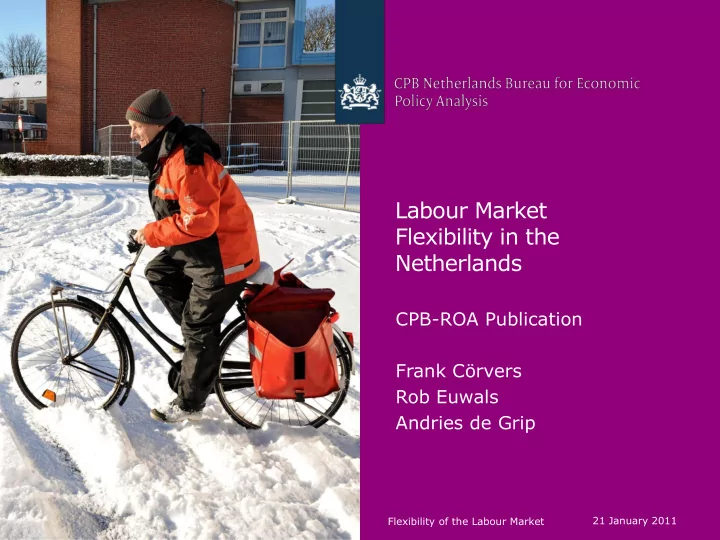

Labour Market Flexibility in the Netherlands CPB-ROA Publication Frank Cörvers Rob Euwals Andries de Grip Flexibility of the Labour Market 21 January 2011
Introduction Temporary employment …under discussion in the Netherlands …low wages, uncertainty… Permanent employment …low levels of worker mobility … increasing wages with tenure Self-employment …low level of insurance …on the rise CPB Netherlands Bureau for Economic Policy Analysis 2 Flexibility of the Labour Market 21 January 2011
Introduction Policy discussion What is the role of the various types of labour? Impact of policy on labour market? Contribution of this study New empirical evidence on Netherlands Framework to discuss advantages and disadvantages of labour market flexibility CPB Netherlands Bureau for Economic Policy Analysis 3 Flexibility of the Labour Market 21 January 2011
Introduction CPB Netherlands Bureau for Economic Policy Analysis 4 Flexibility of the Labour Market 21 January 2011
Overview 1. Framework: role of contracts and self-employment 2. Permanent contracts: wage-tenure profiles 3. Self-employment: success of self-employment 4. Flexible contracts: recent graduates 5. Flexible contracts: human capital 6. Conclusions CPB Netherlands Bureau for Economic Policy Analysis 5 Flexibility of the Labour Market 21 January 2011
(1) Framework: highly educated men % 1 00 90 80 70 60 50 40 30 20 1 0 0 1 5-25 25-35 35-45 45-55 55-65 permanent temporary self-employed CPB Netherlands Bureau for Economic Policy Analysis 6 Flexibility of the Labour Market 21 January 2011
(1) Framework: lowly educated women % 1 00 90 80 70 60 50 40 30 20 1 0 0 1 5-25 25-35 35-45 45-55 55-65 permanent temporary self-employed CPB Netherlands Bureau for Economic Policy Analysis 7 Flexibility of the Labour Market 21 January 2011
(1) Framework Temporary contracts: Relatively common among the young Role of such contracts: Flexibility for firms and particular groups of workers Screening device for firms (and some workers) Level of worker-firm commitment low New evidence in chapters 4, 5 and 6 CPB Netherlands Bureau for Economic Policy Analysis 8 Flexibility of the Labour Market 21 January 2011
(1) Framework Permanent contract: High education: max incidence at ages 25-35 Low education: max incidence at ages 45-55 Role of such contracts: Commitment device human capital investments Low flexibility for firms, hardly impede workers Firms reluctant to hire permanent workers for jobs with little human capital investments because of uncertainty about ability of worker New evidence in chapter 3 CPB Netherlands Bureau for Economic Policy Analysis 9 Flexibility of the Labour Market 21 January 2011
(1) Framework Self-employment: Relatively common among older workers Role of such employment: Flexibility for firms hiring self-employed Flexibility for workers in case of deliberate choice Level of worker-firm commitment low May act as screening device New evidence in chapter 7 CPB Netherlands Bureau for Economic Policy Analysis 10 Flexibility of the Labour Market 21 January 2011
Overview 1. Framework: role of contracts and self-employment 2. Permanent contracts: wage-tenure profiles 3. Self-employment: success of self-employment 4. Flexible contracts: recent graduates 5. Flexible contracts: human capital 6. Conclusions CPB Netherlands Bureau for Economic Policy Analysis 11 Flexibility of the Labour Market 21 January 2011
(2) Wage-tenure profiles Dutch labour market High level of protection for permanent jobs Low level of mobility at each age group Relatively long unemployment durations Research questions Are Dutch wage-tenure profiles steep? Impact employment protection on wages? Are steep profiles related to low mobility? CPB Netherlands Bureau for Economic Policy Analysis 12 Flexibility of the Labour Market 21 January 2011
(2) Wage-tenure profiles E PL index (2006) 4,5 regular contracts Prt 4,0 3,5 Ger E sp 3,0 NL Fra 2,5 2,0 It Dk Aus 1 ,5 UK 1 ,0 0,5 0,1 0 0,1 5 0,20 0,25 0,30 0,35 0,40 0,45 0,50 share workers tenure > 1 0 years CPB Netherlands Bureau for Economic Policy Analysis 13 Flexibility of the Labour Market 21 January 2011
(2) Wage-tenure profiles Empirical results • Wages increase rather strong with tenure • Irrespective of estimation method • Employment protection increases wages • Low worker mobility related to high wages (at sectoral level) Policy • Challenge for sectors/firms with ageing workforce • Maintaining or upgrading productivity of older workers • Efficiently allocating older workers to tasks CPB Netherlands Bureau for Economic Policy Analysis 14 Flexibility of the Labour Market 21 January 2011
Overview 1. Framework: role of contracts and self-employment 2. Permanent contracts: wage-tenure profiles 3. Self-employment: success of self-employment 4. Flexible contracts: recent graduates 5. Flexible contracts: human capital 6. Conclusions CPB Netherlands Bureau for Economic Policy Analysis 15 Flexibility of the Labour Market 21 January 2011
(3) Success of Self-employment Dutch labour market Substantial share of self-employed And this share is on the rise Research questions Which self-employed survive? Which self-employed enter paid employment? CPB Netherlands Bureau for Economic Policy Analysis 16 Flexibility of the Labour Market 21 January 2011
(3) Success of Self-employment % 35 30 25 20 1 5 1 0 5 0 1 986 1 988 1 990 1 992 1 994 1 996 1 998 2000 2002 2004 2006 2008 Netherlands S pain UK G ermany US Belgium CPB Netherlands Bureau for Economic Policy Analysis 17 Flexibility of the Labour Market 21 January 2011
(3) Success of Self-employment Empirical results About 50% survives for at least 5 years Not-survivors: 60% enters paid employment Disadvantaged have lower survival probability Still some survive or enter paid employment Policy Self-employment may act as steppingstone Self-employment alternative for older workers CPB Netherlands Bureau for Economic Policy Analysis 18 Flexibility of the Labour Market 21 January 2011
Recommend
More recommend